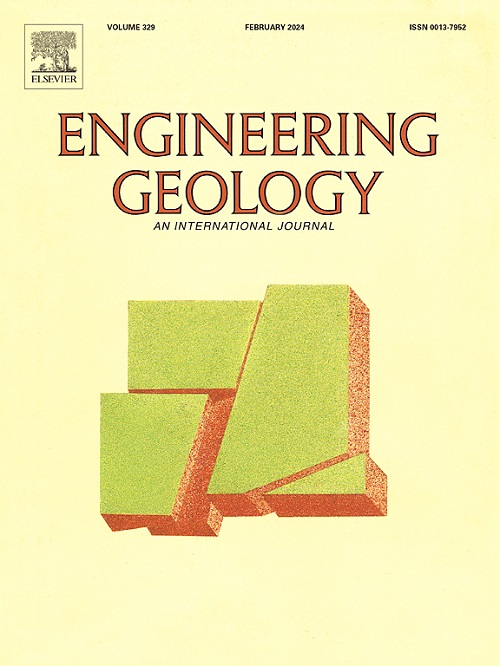Uncertainty analysis of 3D post-failure behavior in landslide and reinforced slope based on the SPH method and the random field theory
IF 6.9
1区 工程技术
Q1 ENGINEERING, GEOLOGICAL
引用次数: 0
Abstract
At present, the three-dimensional (3D) landslide post-failure behaviors probabilistic model has been limited due to many technical challenges, especially computational efficiency. This also restrains the exploration of the impact of geometries and geo-conditions in the direction perpendicular to the 2D plane. This study proposes a novel 3D stochastic numerical simulation model combined the high-performance GPU-accelerated SPH method with geotechnical random field theory. Utilizing GPUs for deterministic calculation of landslide large deformation post-behavior achieves computational speeds exceeding those of CPUs by approximately 53 to 100 times. Furtherly, the computational cost as low as 4.3 min per deterministic sample, thus markedly enhancing computational efficiency. Moreover, it considers the number of Karhunen-Loève expansion terms, the fluctuation scale of anisotropy in the direction perpendicular to the 2D plane, and the cross-correlation of the internal friction angle and cohesion to illustrate their influence on probability distribution and variability of landslide behavior indexes. Additionally, slope model with retaining wall is conduct for risk assessment, which suggests that strengthening reinforcement of slope may not only restrains the post-failure behavior of landslide, but also optimizes the probability distribution of its evaluation indexes, reducing the difficulty of prediction. The 3D stochastic simulation framework excels in characterizing complex slope geometries and geo-conditions, providing more accurate risk assessment and mechanism analysis of landslides. This study advances the understanding of 3D landslide large deformation risk analysis, offering practical insights for real-region slope engineering application.
基于SPH法和随机场理论的滑坡加筋边坡三维失稳后特性不确定性分析
目前,三维滑坡失稳后行为概率模型的建立受到诸多技术挑战,尤其是计算效率的限制。这也限制了在垂直于二维平面的方向上探索几何形状和地质条件的影响。将高性能gpu加速SPH方法与岩土随机场理论相结合,提出了一种新的三维随机数值模拟模型。利用gpu进行滑坡大变形后行为的确定性计算,计算速度大约是cpu的53 ~ 100倍。此外,每个确定性样本的计算成本低至4.3 min,从而显著提高了计算效率。考虑karhunen - lo展开项数、垂直于二维平面方向各向异性波动尺度、内摩擦角和黏聚力相互关系对滑坡行为指标概率分布和变异性的影响。并建立了含挡土墙的边坡模型进行风险评估,表明加强边坡加固不仅可以抑制滑坡失稳后的行为,还可以优化其评价指标的概率分布,降低预测难度。三维随机模拟框架在描述复杂的边坡几何形状和地质条件方面具有优势,可提供更准确的滑坡风险评估和机制分析。本研究促进了对三维滑坡大变形风险分析的认识,为实际区域边坡工程应用提供了实际见解。
本文章由计算机程序翻译,如有差异,请以英文原文为准。
求助全文
约1分钟内获得全文
求助全文
来源期刊

Engineering Geology
地学-地球科学综合
CiteScore
13.70
自引率
12.20%
发文量
327
审稿时长
5.6 months
期刊介绍:
Engineering Geology, an international interdisciplinary journal, serves as a bridge between earth sciences and engineering, focusing on geological and geotechnical engineering. It welcomes studies with relevance to engineering, environmental concerns, and safety, catering to engineering geologists with backgrounds in geology or civil/mining engineering. Topics include applied geomorphology, structural geology, geophysics, geochemistry, environmental geology, hydrogeology, land use planning, natural hazards, remote sensing, soil and rock mechanics, and applied geotechnical engineering. The journal provides a platform for research at the intersection of geology and engineering disciplines.
 求助内容:
求助内容: 应助结果提醒方式:
应助结果提醒方式:


